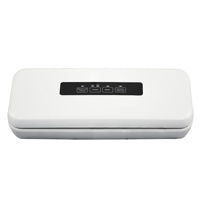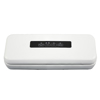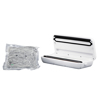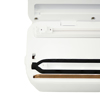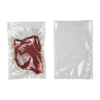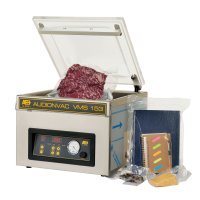Loading products
What is a vacuum sealing machine?
These solutions use heat sealing and vacuum chamber technology to remove the air from a vacuum bag to tightly encase the contents and seal the opening shut. This product performs both of these tasks inside the machine and is operated via intuitive button functions on the lid. Kite Packaging’s sealing machine also features a guillotine style cutter to trim bags cleanly down to size to streamline packages and reduce shipping costs.
What is a vacuum bag?
Kite’s embossed vacuum bags are made from a 75% PE and 25% nylon material and consist of one smooth transparent side and one dotted embossed side, both of 90 micron thickness. The edges are pre-sealed aside from one short side which has an opening ready to be filled with produce before being secured with one of our vacuum sealers or chamber machines.
There is an easy tear incision at the pre-sealed end for greater convenience, efficiency and satisfaction when the item reaches its destination and can be easily accessed. When activated by machine, these vacuum bags demonstrate their unique feature of having all the internal air removed and hence, reducing the size of the parcel down to the smallest possible dimensions. The vacuum packed contents are tightly encased and unlikely to move about inside a mailer.
What are the benefits of this heat sealing model?
This particular vacuum machine is highly compact and cost-effective, making it an excellent solution for smaller traders or companies operating with multiple pack benches who may benefit from a number of these machines distributed across their warehouse. They are comparatively lightweight and very mobile while still reliably offering commercial vacuum sealing capabilities.
Once a product is secured within one of our extra durable embossed vacuum bags, it can enjoy premium protection in transit and a complete lack of movement within a bag; as a result, they are particularly useful for suspending multiple small items, like nuts and bolts, for example. Each item is held in place and prevented from colliding with other objects within the package. Hence, this method of packaging is popular amongst mechanics, DIY distributors and electrics suppliers although almost any industry can see the practical advantages to this low-cost yet highly effective machine.
Vacuum sealing is one of the most hygienic methods of packaging available as no dust or bacteria can enter the bag and contaminate the contents once it is closed. This keeps the vacuum packed product in immaculate condition while reassuring the recipient that utmost care has been taken to stay safe.
Do all vacuum sealers use the same bags?
No, it is worth knowing that not all vacuum bags are compatible with all types of sealers; indeed, this variety of vacuum bag is only compatible with one model of vacuum machine. Together, the products on this page supply professional packing for businesses of various sizes in a range of industry sectors. Buying the right corresponding type of bag to suit the vacuum sealing machine in use will enhance the performance of the solution, ensuring that food lasts longer.
How should vacuum bags be stored?
Kite’s embossed vacuum sleeves can be stored stacked for optimal compactivity provided that the conditions are cool, dry and away from direct sun or heat sources.
How do you use a vacuum sealing machine?
No training is needed to operate these machines and they come complete with an instruction guide. That said, the functions are largely self-explanatory, making it simple to begin minimising your parcels and enjoying extreme postal protection.
Firstly, trim your vacuum bag down to size if necessary using the integrated blade that is safely concealed within the machine.
Next, align the pouch according to your requirements within the machine; the first line contains the vacuum technology that will take the air out of your envelope while the second is the heat sealer. Therefore, it is important to consider where you want the seal to be alongside ensuring that the vacuum part is covering a portion of the bag.
Once the container has been correctly positioned, lower the lid of the sealing system until the two outer release buttons click. Press the vacuum button to begin the suction and sealing process. When complete, press the external buttons to release the lid and take out the vacuumed plastic bag.
What are the different types of vacuum sealers?
This standard vacuum sealer is a low output entry level machine, best for domestic use or as one of multiple systems in a work space. In contrast, you can also get industrial vacuum sealers that are typically larger, allowing for bigger portions of food, for example, to be sealed per application. A variety of accessories can be added to these models such as support stands, work tables, bag supports and roller conveyers. These attachments are designed to adapt the machine toward the specific needs of your products, increasing overall efficiency.It is also important to mark the difference between a vacuum chamber and a vacuum sealer. Vacuum chambers are used by placing the bags inside the machine whereas vacuum sealers operate with the bags on the outside. The chamber is stripped of air via a pump, the bag sealed by a built-in heat sealer and finally, air is returned in order for the vacuum packed product to then be removed. This process is carried out entirely externally when using a vacuum sealer.





